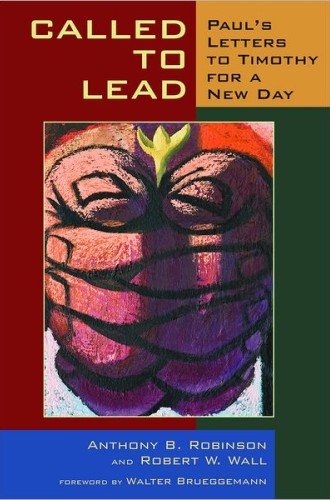Called to Lead, by Anthony B. Robinson and Robert W. Wall
In 2006, New Testament scholar Robert Wall and pastor Anthony Robinson coauthored Called to Be Church, a study of the book of Acts. Each chapter of that volume has two sections: Wall provides an interpretation of the biblical text, then Robinson reflects on how the text bears on the life of the church. The format is not unique. Many biblical commentaries include both scholarly exegesis and pastoral commentary. But the pairing of these two authors is particularly fruitful. Their writing has the feel of an extended dialogue between two smart and faithful Christians who share common commitments but bring different areas of expertise to the conversation. The book succeeds in delineating ways in which Acts is both relevant and helpful for church life today.
In Called to Lead, Wall and Robinson have teamed up again, using the same format. This time, however, they have taken on a much more challenging subject—the pastoral letters to Timothy. The authors are well aware of the challenge, granting that for nearly two centuries the letters “have suffered from bad press and neglect”—for two major reasons.
Read our latest issue or browse back issues.
First, in scholarly circles there is considerable doubt that these epistles, attributed to Paul, were actually written by him. Rather, given a convention that was quite common in the ancient world, it is possible that they were written under Paul’s name to draw on his authority and to affirm that they were consistent with his teaching. For some contemporary readers, doubts about the authorship of the letters calls their authority into question. (In this review, I refer to the author as Paul, but more out of convenience than conviction.)
Wall and Robinson do not take a definitive position on whether or not Paul wrote 1 and 2 Timothy. Instead, they take a canonical approach that recognizes the authority of the letters not because of their authorship, but because of their inclusion in the canon. They also point to the characteristic the letters have in common with other portions of scripture: through the centuries they have demonstrated an ability to draw the reader “into a more intimate and wakeful fellowship with the living God.”
The second challenge facing an interpreter of the pastoral letters is more vexing: they contain notorious “texts of terror” that have been used and misused over the centuries to justify injustice. The counsel to women to “learn quietly in complete submission” (1 Tim. 2:11) has been deployed to repress women in many times and settings. The assertion that “those who carry the yoke of slavery must respect their own masters” (1 Tim. 6:1) was frequently cited by people who defended the institution of slavery in antebellum America.
Wall spends considerable time addressing these two problematic passages, setting them within the historical context in which they were written, as well as within the rest of the biblical narrative. He tries to make the case that when the texts are read in this way, they do not sanction repression at all, but actually represent an egalitarian impulse. In the letters women at least are recognized as an integral part of the church and are allowed to learn, which would not have been common practice at the time. Slaves do remain slaves, but they are also siblings in Christ to the slaveholder.
Whether or not Wall is entirely convincing in making this case, it was probably necessary to address these texts at some length. Otherwise, the reader might not be willing to give the other portions of these letters much of a hearing. And there are considerable benefits in doing so.
Most of the letters that Paul wrote or that bear his name are addressed to congregations. But these are a pastor’s letters to another pastor, and their subject is the nature and practice of pastoral leadership. Wall and Robinson contend—here quite convincingly—that 1 and 2 Timothy are both timeless and timely. They were written in a context of great uncertainty. Paul, the founding pastor of the church in Ephesus, had taken to the road, leaving the young pastor Timothy to lead a congregation that faced many challenges. The church sought to nurture discipleship in the midst of a society that was ordered and governed by the principles of the Roman Empire. Questions about the nature and exercise of authority were at the forefront. Robinson and Wall contend that the central question before Timothy and before pastors today is the same: “When authority is contested regularly, what does it mean to lead a congregation wisely and well?”
Perhaps because in our time there is no longer a firm consensus on what it means “to lead a congregation wisely and well,” books on pastoral leadership are legion. Most of these books, however, borrow approaches and vocabulary from the social sciences. We read about family systems theory as it applies to congregational life. Or we retrofit theories of institutional change that emerge from business schools to inform our thinking about how congregations navigate change. Of course, there is nothing inherently wrong with gathering insights wherever we find them. The problem is that a preponderance of such approaches can crowd out theological reflection.
Counter to this trend, Robinson insists that we need to think theologically about the church, including pastoral leadership, and then he helps us do just that. To the question in the title of his brilliant book What’s Theology Got to Do with It?, his answer is, “Everything.”
In Called to Lead, Robinson builds on the solid exegetical foundation provided by Wall to offer an extended biblical and theological reflection on pastoral leadership, often finding in the pastoral letters to Timothy a corrective to current thinking. We tend to talk about the worship and mission of the church as if they are different aspects of a congregation’s life; Paul approaches the two as if they are as inextricably related as two steps of the same dance. These days we seek certain skills and experience in a pastor; Paul is much more interested in a pastor’s character and spiritual maturity. Today there is no end to advocacy of clergy self-care, as if that is the highest good to be achieved; Paul offers the much more nuanced reminder to “tend to yourself and to your teaching”—a bracing alternative to self-absorption.
On occasion Robinson leaps atop a favorite hobbyhorse without much visible boost from the text. It is a bit of a stretch, for instance, to find a case for strong church bylaws in Paul’s advice on how to order one’s household. But that is nothing more than a minor quibble. For the most part, his reflections are not only faithful to the text but also illuminating and helpful.
The most important insight in this book is not any particular suggestion on how pastors can lead more effectively. Rather, the key insight comes in the form of a reminder and a charge: pastors are to lead. The challenges to pastoral leadership in our time are so daunting that many pastors simply refuse to lead. We normally use the phrase “abuse of power” to describe actions that are autocratic or self-serving. Wall and Robinson contend, however, that there is another way to abuse power, and that is to fail “to exercise power responsibly and for the health of the household of God.” That is, to refuse to lead is an abuse of power. Leadership is not just a skill but a virtue that closely resembles courage and even self-sacrificial love.






